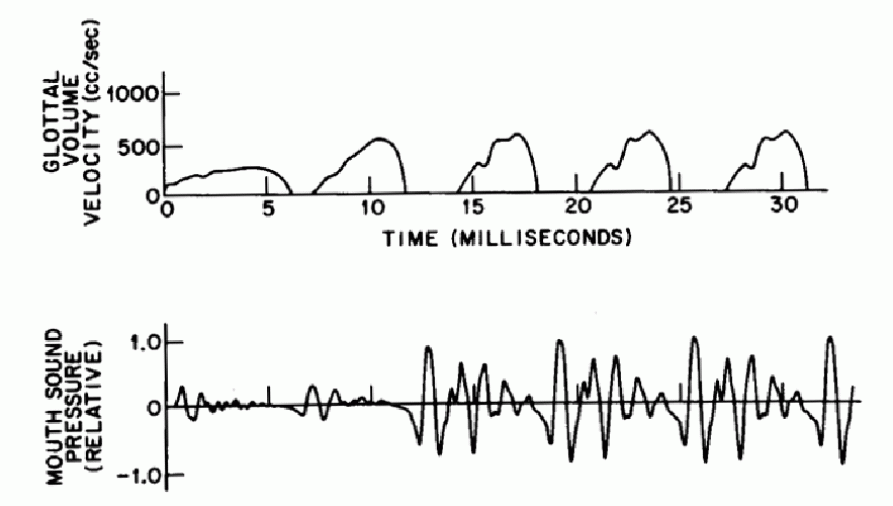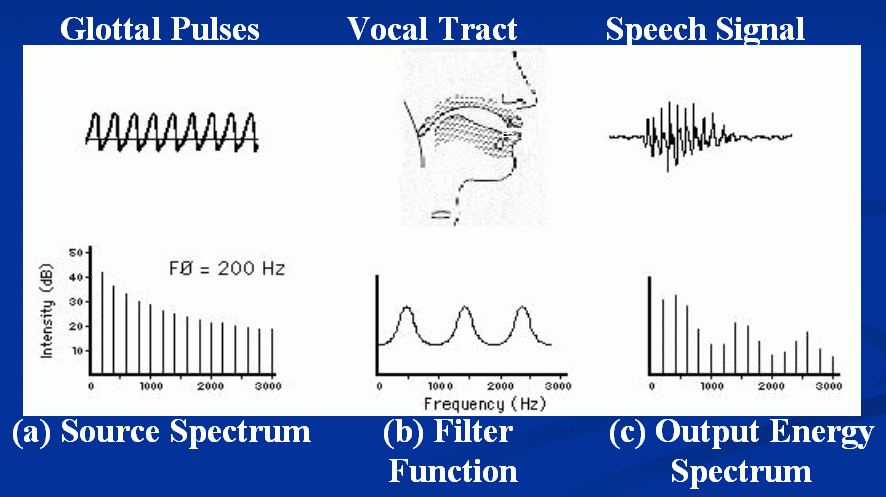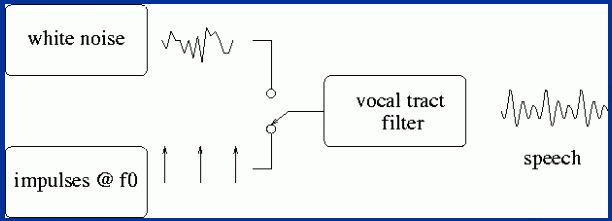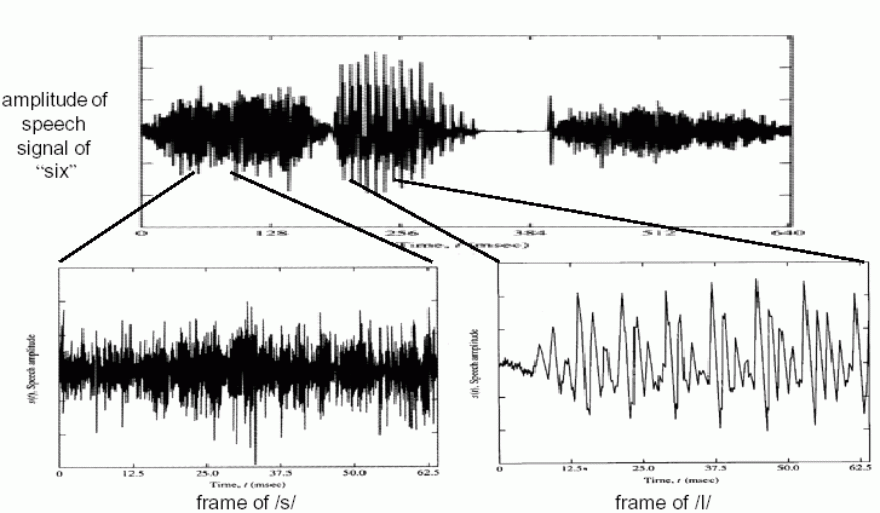The procedure from human voice production to voice recognition involves the following steps:
- Rapid open and close of your vocal cords (or glottis) to generate the vibration in air flow.
- Resonance of the pharyngeal cavity, nasal cavity, and oral cavity.
- The vibration of air.
- The vibration of the ear drum (or tympanum).
- The reception of the inner ear.
- The recognition by the brain.
人聲的發音與接收流程,可以列出如下:
- 聲門的快速打開與關閉
- 聲道、口腔、鼻腔的共振
- 空氣的波動
- 接收者耳膜的振動
- 內耳神經的接收
- 大腦的辨識

The production mechanism of human voices.
人聲的發音機制
- The vibration frequency of the vocal cords determines the pitch of the voices.
- The positions/shapes of your lips, tongue, and nose determine the timbre.
- The compression from your lungs determine the loudness of the voices.
由於聲門(Glottis)的肌肉張力,加上由肺部壓迫出來的空氣,就會造成聲門的快速打開與關閉,這個一疏一密的空氣壓力,就是人聲的源頭,在經由聲道、口腔、鼻腔的共振,就會產生不同的聲音(音色)。換句話說:
- 聲門震動的快,決定聲音的基本頻率(即音高)。
- 口腔、鼻腔、舌頭的位置、嘴型等,決定聲音的內容(即音色)。
- 肺部壓縮空氣的力量大小,決定音量大小。
The following figure demonstrates the airflow velocity around the glottis and the voice signals measured around the mouth.
下面這一張圖,顯示聲門附近的空氣流速,以及最後在嘴巴附近所量測到的聲波:

Airflow velocity around the glottis and the resultant voices signals
You can observe the movement of the vocal cords from the following link:
經由下面這個連結,可以看到聲門運動的現象:
In fact, it is not easy to capture the movements of vocal cords due to its high frequency in movement. So we need to have high-speed cameras for such purpose, for instance:
要拍到聲門運動,是相當不容易,必須使用高速的攝影機,例如
We can conceive the production of human voices as a source-filter model where the source is the airflow caused by the vocal cords, and the filter includes the pharyngeal/nasal/oral cavities. The following figure shows the representative spectrum for each stage:
所以人發音的過程,是由訊號源(聲門),經過濾波器(口腔、鼻腔、嘴型等),才得到最後的聲音,這個過程可以和頻譜訊號一一對應如下:

Source-filter model and the corresponding spectra
人聲發音過程與與頻譜的對應
We can also use the following block diagram to represent the source-filter model of human voice production:
若用數學模型表示,可用下列方塊圖:

Block diagram representation of source-filter model
人聲發音過程的數學模型
In general, a regular vibration of the glottis will generate quasi-periodic voiced sounds. On the other hand, if the source is irregular airflow, then we will have unvoiced sounds. Take the utterance of "six" for example:
一般來說,當訊號源是間隔規律的波形時,通常代表有聲音,如果訊號源是雜亂的訊號,則得到氣音,以下列的發音「six」為例:

Unvoiced and voiced sounds
氣音和有聲音
We can clearly observe that "s" and "k" are unvoiced sounds, while "i" is a voiced sound.
其中「s」和「k」都是無聲的氣音,只有「i」是有聲音。
For Mandarin, almsot all unvoiced sounds happen at the beginning of a syllable. Take the utterance of "清" as in "清華大學" for example:
- No vibration from the glottis. Close your teech and push forward your tongue tip against the lower teeth to generate the unvoiced sound "ㄑ" by a jet of airflow.
- Keep almost the sampe position but start glottis vibration to pronunce the voiced "ㄧ".
- Keep glottis vibrate but retract your tongue to pronuced the final voiced "ㄥ".
一般而言,中文的氣音只發生在字頭,不會是在字尾。以「清華大學」的「清」為例:
- 聲門不震動,上下顎咬合,舌頭前伸,完全是氣音,發出「ㄑ」
- 姿勢類似,聲門震動,發出「ㄧ」。
- 聲門維持同樣的震動,但是舌頭後縮,發出「ㄥ」。
Here are some terminologies in both English and Chinese for your reference:
以下是一些名詞的中英對照表:
- Cochlea:耳蝸
- Phoneme:音素、音位
- Phonics:聲學;聲音基礎教學法(以聲音為基礎進而教拼字的教學法)
- Phonetics:語音學
- Phonology:音系學、語音體系
- Prosody:韻律學;作詩法
- Syllable:音節
- Tone:音調
- Alveolar:齒槽音
- Silence:靜音
- Noise:雜訊
- Glottis:聲門
- larynx:喉頭
- Pharynx:咽頭
- Pharyngeal:咽部的,喉音的
- Velum:軟顎
- Vocal chords:聲帶
- Glottis: 聲門
- Esophagus:食管
- Diaphragm:橫隔膜
- Trachea:氣管
Audio Signal Processing and Recognition (音訊處理與辨識)
